Recently, while browsing my local pet shop, I noticed some vibrant new fish that immediately caught my eye. Their body shape seemed familiar, but the colors were unlike anything I had seen before. Now, I’m not usually a fan of genetically modified fish, but in this case, I have to admit—the fish deserves some attention. Allow me to introduce you to the GloFish!
These fish, engineered to glow in a variety of bright neon colors, are a stunning addition to any aquarium. Originally created for scientific research, they’ve since become popular with hobbyists for their unique appearance. Whether you’re intrigued by their bold patterns or curious about their background, GloFish are certainly worth a closer look.
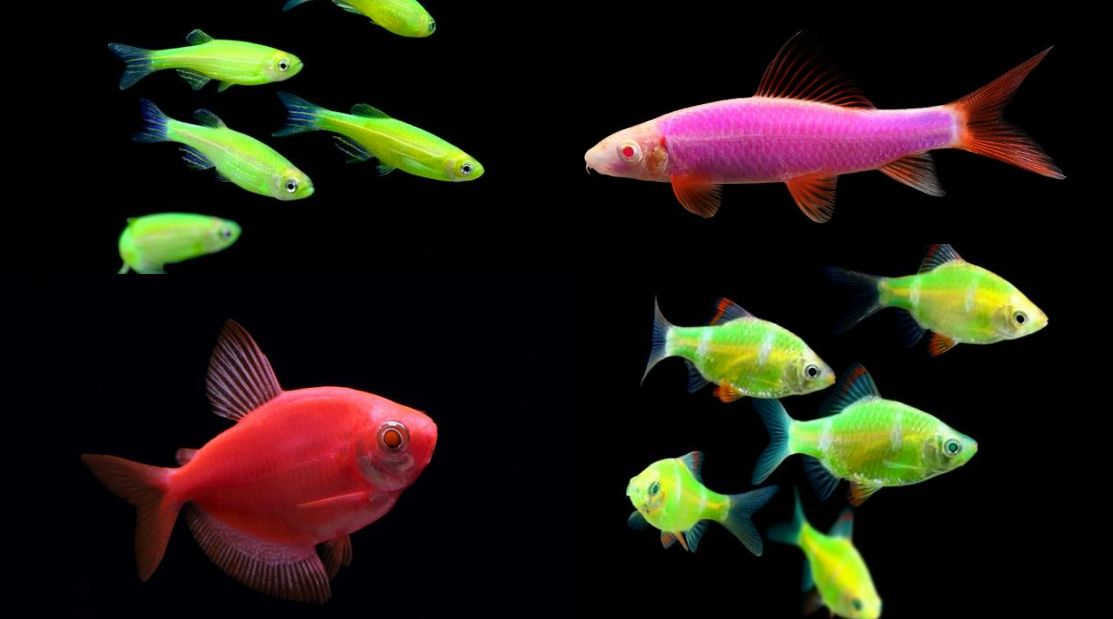
Contents
The story of creation
As you may have guessed, GloFish do not exist in the wild. They are a patented brand of genetically modified fluorescent fish, combining the words “glow” and “fish.” While GloFish is a U.S.-based brand, the fish are officially bred by Taikong Corp in Taiwan.
How are GloFish Made?
GloFish were developed through genetic modification to achieve their vibrant, glowing appearance. By introducing a gene from the Pacific jellyfish into the DNA of the fish, scientists enabled the production of green fluorescent protein (GFP), which gives the fish their neon glow. The first species modified this way was the zebrafish, a small, hardy species commonly kept in aquariums.
The process didn’t stop there. Different genes from jellyfish and coral were added to produce various colors. For example, zebrafish modified with jellyfish DNA glow green, while those with coral DNA glow red. If both genes are present, the fish take on a yellow hue. These fluorescent proteins cause the fish to glow brightly when exposed to ultraviolet or blue light.
The Origin of GloFish
Originally, this genetic modification had a scientific purpose. The fish were designed as environmental indicators, meant to glow in response to toxins in the water. However, at a scientific conference, their striking appearance caught the attention of an aquarium fish company. This led to a collaboration that resulted in the creation of the GloFish brand, which now offers a variety of fluorescent species for home aquariums.
What Makes GloFish Glow?
The glow in GloFish comes from specific genes introduced into their DNA, such as the green fluorescent protein (GFP) from jellyfish and the red fluorescent protein (RFP) from coral. These proteins produce light when exposed to certain wavelengths. By using specialized LED lights, typically blue or ultraviolet, the proteins in GloFish are “excited,” causing them to emit their signature fluorescent glow. This glow can be seen in their skin, scales, and even internal organs, making them a visually striking addition to any tank.
Types of glofish
It’s important to note that while GloFish display their unique fluorescence, this genetic modification doesn’t change their basic care requirements or behavior compared to non-modified fish. Once these fish are born, their fluorescent colors are present and remain throughout their lives, often becoming more vivid as they grow. This characteristic is also passed down to their offspring when breeding transgenic species.
In 2012, a new fluorescent fish species was introduced—named “Electric Green” GloFish. This time, instead of using zebrafish, scientists used the black tetra to create the glowing effect.
Three years later, in 2015, the vibrant green tiger barb hit the market, adding to the variety of glowing species. More recently, the glo-rainbow shark became available, offering aquarium enthusiasts even more colorful options for their tanks.
Despite their eye-catching colors, all GloFish species share the same care requirements as their non-fluorescent counterparts, making them an easy and captivating addition to any aquarium.
GloFish tetra
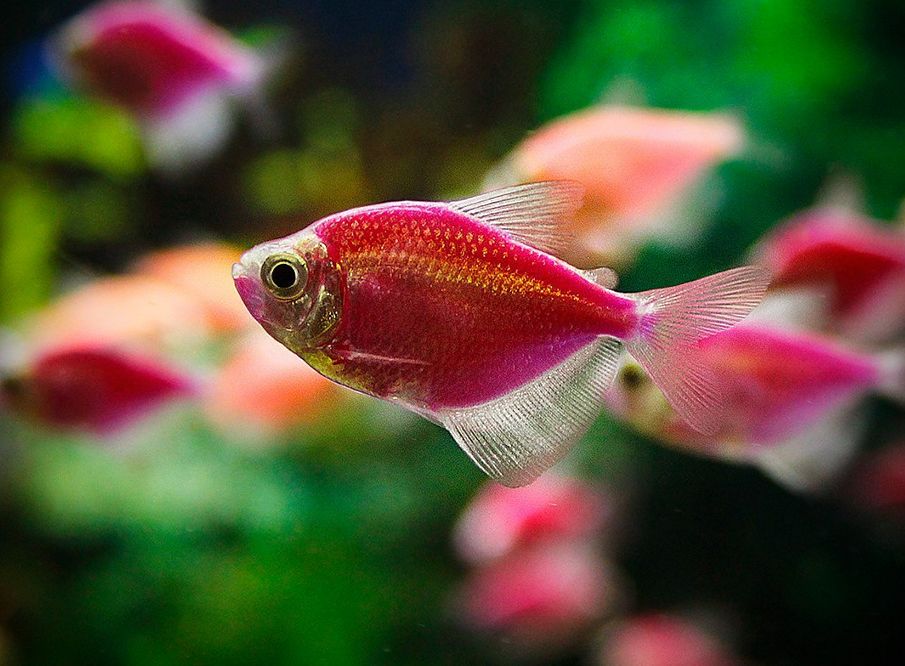
GloFish tetras (Gymnocorymbus ternetzi) are genetically modified versions of the black skirt tetra, sharing the same scientific name but standing out for their vibrant fluorescent glow. These fish were first introduced in 2012, thanks to a collaboration between scientists and aquarium businesses, bringing a new dimension of color to aquarium design. Despite their glow, GloFish tetras retain all the characteristics of their non-modified counterparts—their size, lifespan of 3-5 years, behavior, and diet remain unchanged.
One subtle difference is the lack of visual gender dimorphism. Both males and females share the same glowing coloration, but females typically have a slightly rounder abdomen. This makes them visually similar, unlike many other species where males and females are more distinct.
The GloFish tetra’s bright, fluorescent color won’t fade or change over time. Since the glowing gene is embedded in their genetic code, it’s passed down to their offspring. To fully appreciate their glow, blue lighting is recommended, such as using blue LED or specialized GloFish lights. While they still look attractive under regular white lights, their glow is much more pronounced with blue light.
Their unpretentious nature and stunning colors make GloFish tetras an excellent choice for both beginner and experienced aquarists. These fish are as easy to care for as their non-glowing relatives, requiring no special attention beyond regular aquarium maintenance and proper lighting.
| Characteristic | Description |
|---|---|
| Common Names | Glofish Tetra |
| Origin | Originally found in India, but bred selectively for color |
| Size | 1.5 to 2 inches (3.8 to 5 cm) in length |
| Lifespan | 2 to 3 years |
| Water Parameters | Temperature: 72-82°F (22-28°C), pH: 6.5-7.5 |
| Behavior | Active and schooling fish |
| Color Variations | Fluorescent and brightly colored (red, green, orange, etc.) |
| Diet | Omnivorous; eats both live and commercial fish food |
| Tank Size | Minimum 10 gallons (37 liters) for a small school |
| Tank Setup | Well-planted tank with hiding places, open swimming areas |
| Compatibility | Peaceful and compatible with other small, non-aggressive fish |
| Breeding | Egg-scatterers; breeding can be challenging |
| Special Considerations | May require special lighting for optimal color display |
GloFish barb
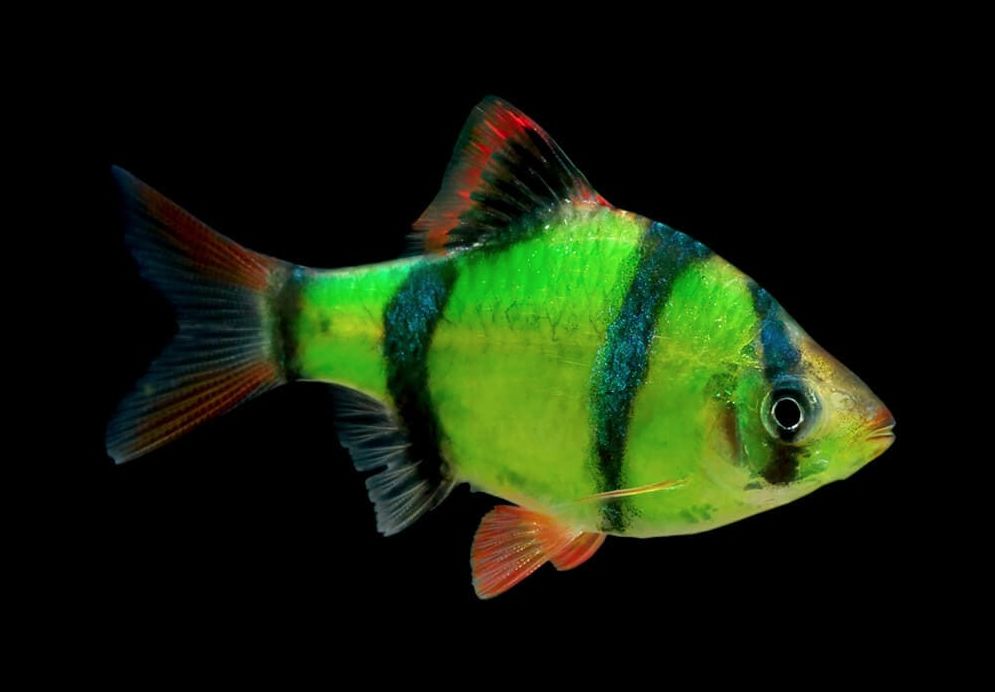
In 2012, genetic scientists introduced the vibrant GloFish barb, a bright green-yellow version of the tiger barb with faint vertical stripes and red-edged fins. This was followed in 2015 by a striking “high-contrast” barb, featuring bold black stripes and black fins, and later, a glowing red variety. Aside from their fluorescent glow, these fish remain quite similar to their natural counterparts in size, lifespan, behavior, and diet.
GloFish barbs are hardy and undemanding in terms of tank parameters, but it’s ideal to keep them in a moderately elongated aquarium with a cover, as they are active swimmers. While they enjoy open spaces for swimming, the tank should also feature plants that leave some clear areas for them to explore.
Much like common tiger barbs, GloFish barbs are energetic and prefer to swim in the middle and lower layers of the tank. They thrive in community tanks, but it’s important to keep them in groups of at least 6-8 to prevent them from becoming less active or displaying poor behavior. These social fish feel more comfortable in larger schools, where their natural instincts and active behavior can shine.
In terms of diet, GloFish barbs are not picky eaters. They can be fed a variety of foods, including flakes, small pellets, and frozen options like daphnia, brine shrimp, cyclops, and bloodworms. Their dietary needs are simple, making them a great addition for both novice and experienced aquarists.
| Scientific Name | Puntius tetrazona |
| Family | Cyprinidae |
| Common Names | Glofish barb |
| Range and habitat | Asia |
| Size | up to 10 centimeters (3.9 inches) |
| Lifespan | 3 years |
| Ease of keeping | Medium |
| Minimum tank size | 50 liters (11 gallons) and more |
| Temperament | Sometimes aggressive |
| Diet | Omnivorous |
| Temperature | 21–27 °C (70–81 °F) |
| pH | 6.5-7.5 |
| Water hardness | 5-20 dGH |
Glofish danio
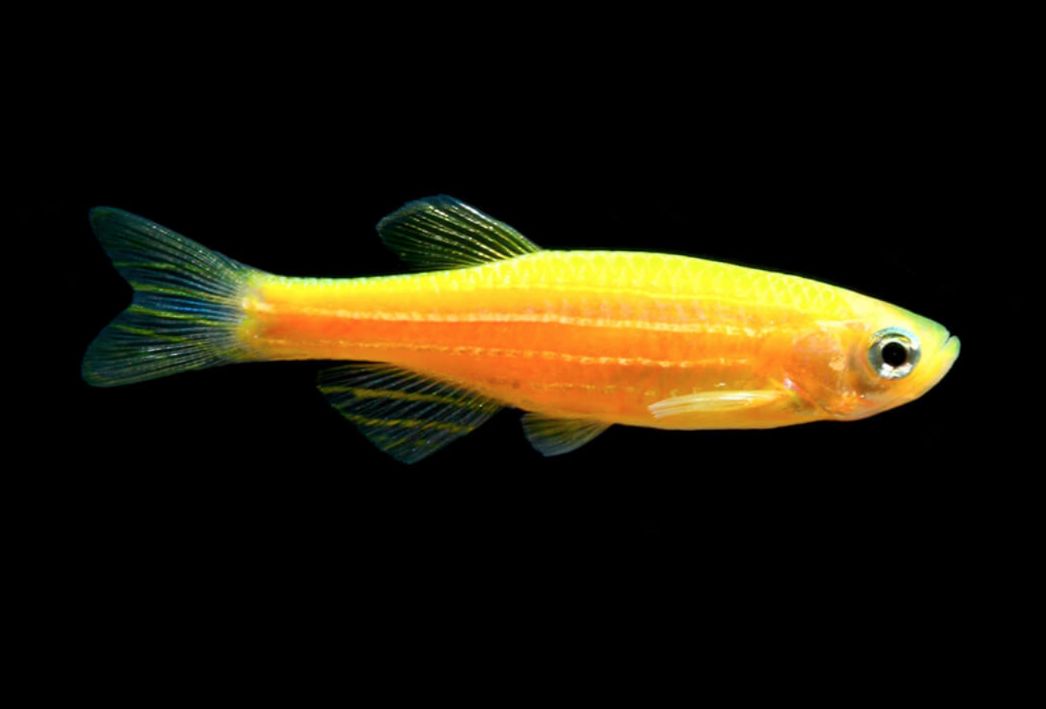
Danio rerio became the first genetically modified pet in 2003, thanks to the introduction of bioluminescent genes. Although this fish wasn’t originally intended for decoration, it quickly became the first widely available genetically modified pet, leading to the creation of the GloFish brand.
GloFish is a patented commercial brand used to sell genetically modified fluorescent fish, with danio rerio as its flagship species. The main feature of GloFish is their vivid red, green, or orange fluorescent coloring, which becomes especially vibrant under UV light. These transgenic fish are created by inserting genetic material from jellyfish and coral into their DNA.
For instance, danios with jellyfish DNA (GFP gene) have a bright green glow, while those with red coral DNA (RFP gene) exhibit a red color. Fish with both genetic markers glow yellow. In 2006, new orange-yellow danios joined the lineup, and by 2011, blue and violet variants were introduced, expanding the variety available to aquarists.
These different GloFish strains are sold under names like Electric Green, Starfire Red, Sunburst Orange, Cosmic Blue, and Galactic Purple. All were created through genetic engineering, using recombinant DNA from various marine corals. Unlike artificially dyed fish, GloFish retain their vibrant coloring throughout their lives and pass it on to their offspring, glowing brightly under UV light.
In terms of care, GloFish danios thrive in warmer water at around 26°C, but otherwise, there are no significant differences in their care, feeding, or breeding compared to non-modified danios. They are peaceful, easy to care for, and make an excellent choice for beginner aquarists.
| Characteristic | Description |
|---|---|
| Common Name | GloFish Danio |
| Scientific Name | Danio rerio |
| Appearance | Small, slender fish with elongated body |
| Size | 1 to 2.5 inches (2.5 to 6.3 cm) |
| Coloration | Vibrant fluorescent colors (red, orange, green, yellow, blue, purple, pink) |
| Lifespan | 2 to 4 years |
| Temperature Range | 72°F to 78°F (22°C to 26°C) |
| pH Range | 6.5 to 7.5 |
| Water Hardness | 5 to 15 dGH |
| Compatibility | Peaceful, can be kept with other small fish |
| Tank Size | 10-gallon minimum for a small group |
| Diet | Omnivorous, will accept flake and live/frozen foods |
| Behavior | Active, schooling fish |
| Breeding Method | Egg scatterer, non-guarding parents |
| Special Considerations | Requires adequate filtration and regular water changes |
| Genetic Modification | Genetically modified with fluorescent proteins from other species |
| Legal Status | Approved for sale in some countries, check local regulations |
GloFish sharks
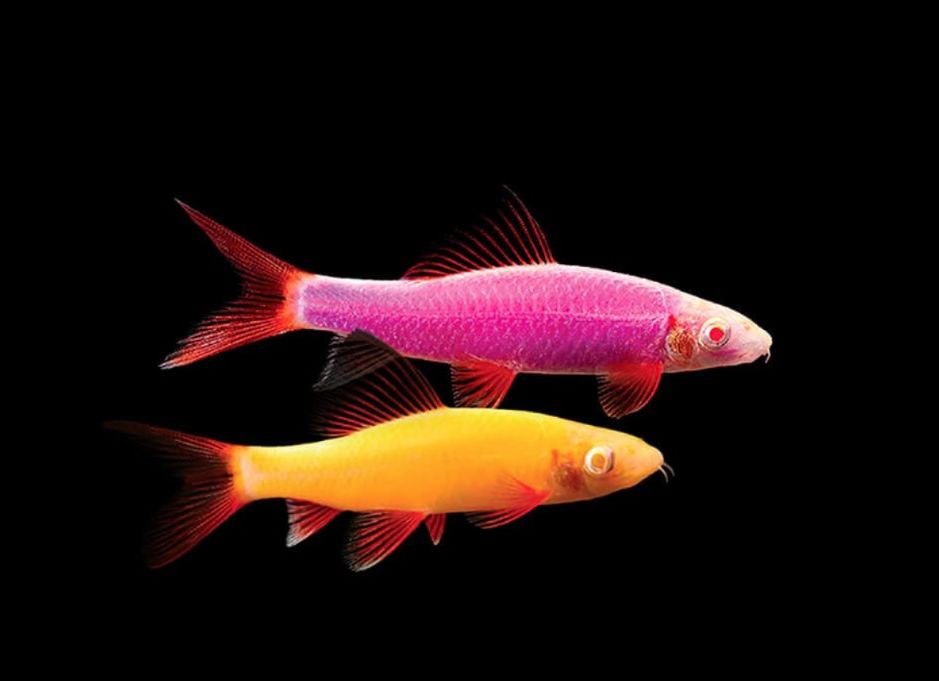
It’s important to recognize that GloFish, while visually stunning, are modified versions of wild species like the red-tailed black shark and rainbow shark. Before making a purchase, I highly recommend learning more about these fish by reading articles that cover their natural behavior and care requirements. Both species are known for being elegant and active, but they can also display territorial and aggressive behavior, especially in community tanks.
This makes the choice of these species for genetic modification surprising. The bright colors of these modified fish may appeal to beginners, but their temperament and care needs can lead to frustration. GloFish may appear harmless at first, but they are not as simple to care for as their vibrant appearance suggests. Beginners should be aware that proper tank conditions, careful stocking, and understanding of their behavior are crucial for successfully keeping these modified fish.
| Scientific Name | Epalzeorhynchos frenatus |
| Family | Cyprinidae |
| Common Names | GloFish shark |
| Range and habitat | Indochina |
| Size | 6 in (15 cm) |
| Lifespan | 4-6 years |
| Ease of keeping | Difficult |
| Minimum tank size | 30 gallons (136 litres) |
| Temperament | Aggressive |
| Diet | Omnivorous |
| Temperature | 21–27 °C (70–81 °F) |
| pH | 6.5-7.5 |
| Water hardness | 5-20 dGH |
Electric Green Cory
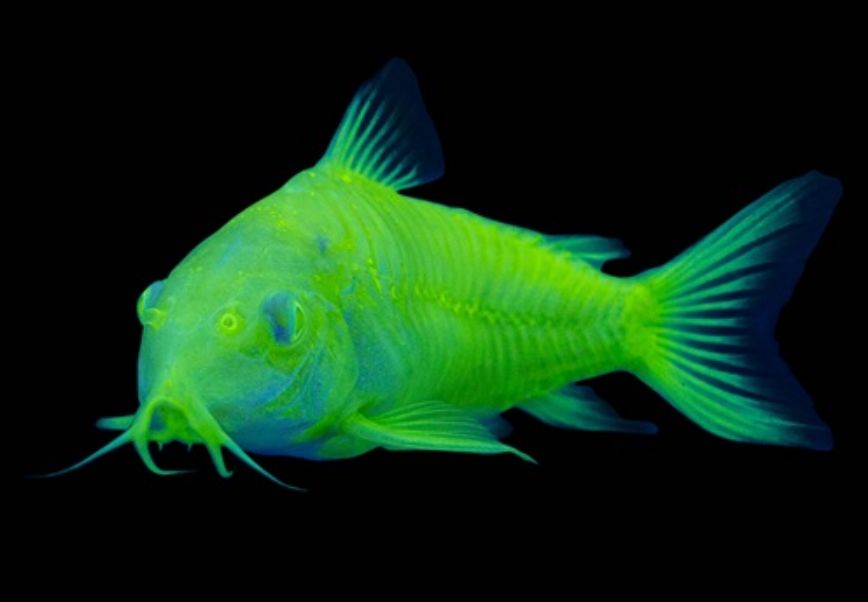
The electric green cory, a vibrant addition to freshwater aquariums, is a striking variant of the Corydoras species. It is believed to have originated from selective breeding of the more common cory species, specifically the bronze cory. The key difference lies in its unique coloration; while the bronze cory features a more muted palette, the electric green cory boasts an eye-catching, luminous green hue that sets it apart.
This species retains the same peaceful nature and social behavior characteristic of corydoras, making it ideal for community tanks. Its lively personality and active scavenging habits add to its appeal. Overall, the electric green cory is not just a beautiful fish but also a hardy and sociable companion for aquarists.
Pristella – Electric Green, Galactic Purple, Sunburst Orange
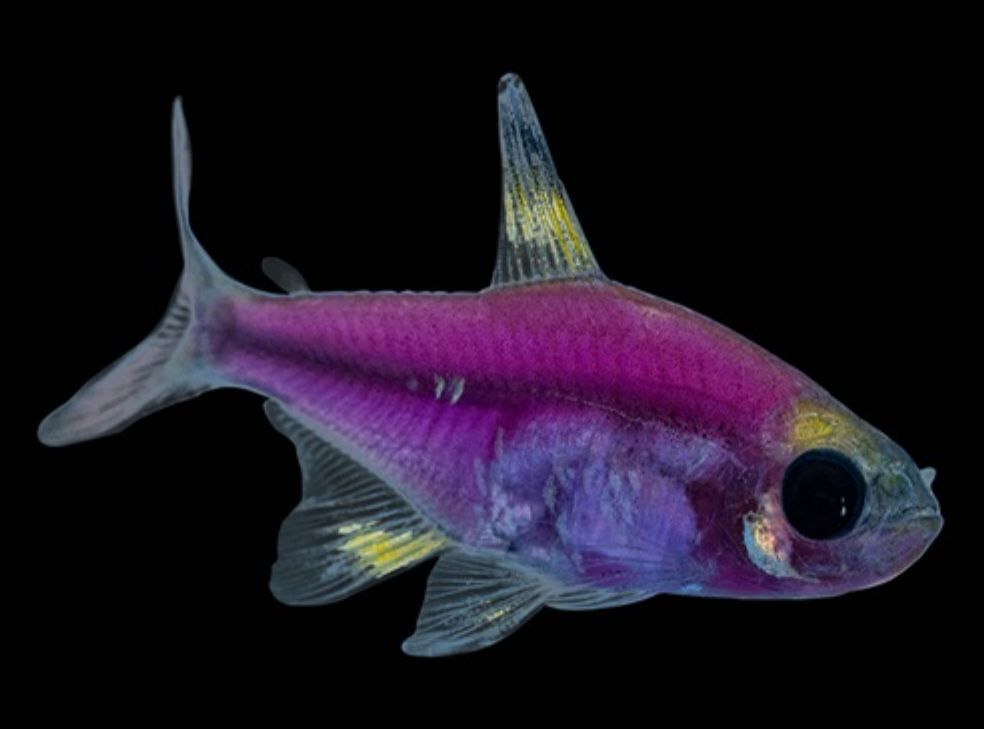
GloFish® Pristellas are a vibrant, genetically modified version of the pristella tetra, originally known for their peaceful nature and schooling behavior. The GloFish® variant features bright fluorescent colors, including neon pink, green, and orange, which are enhanced by the addition of specific fluorescent proteins.
These colorful fish retain the distinctive characteristics of their wild counterparts, such as their small size (about 1.5 inches or 4 cm) and streamlined body. However, GloFish® Pristellas stand out due to their striking glow under UV light, making them a popular choice for aquarists looking to add a lively touch to their tanks.
Unlike traditional pristella tetras, GloFish® are more eye-catching and serve as a fantastic focal point in community aquariums. Their care requirements remain similar, thriving in well-planted tanks with soft, slightly acidic water and a peaceful environment.
Angelfish – Starfire Red
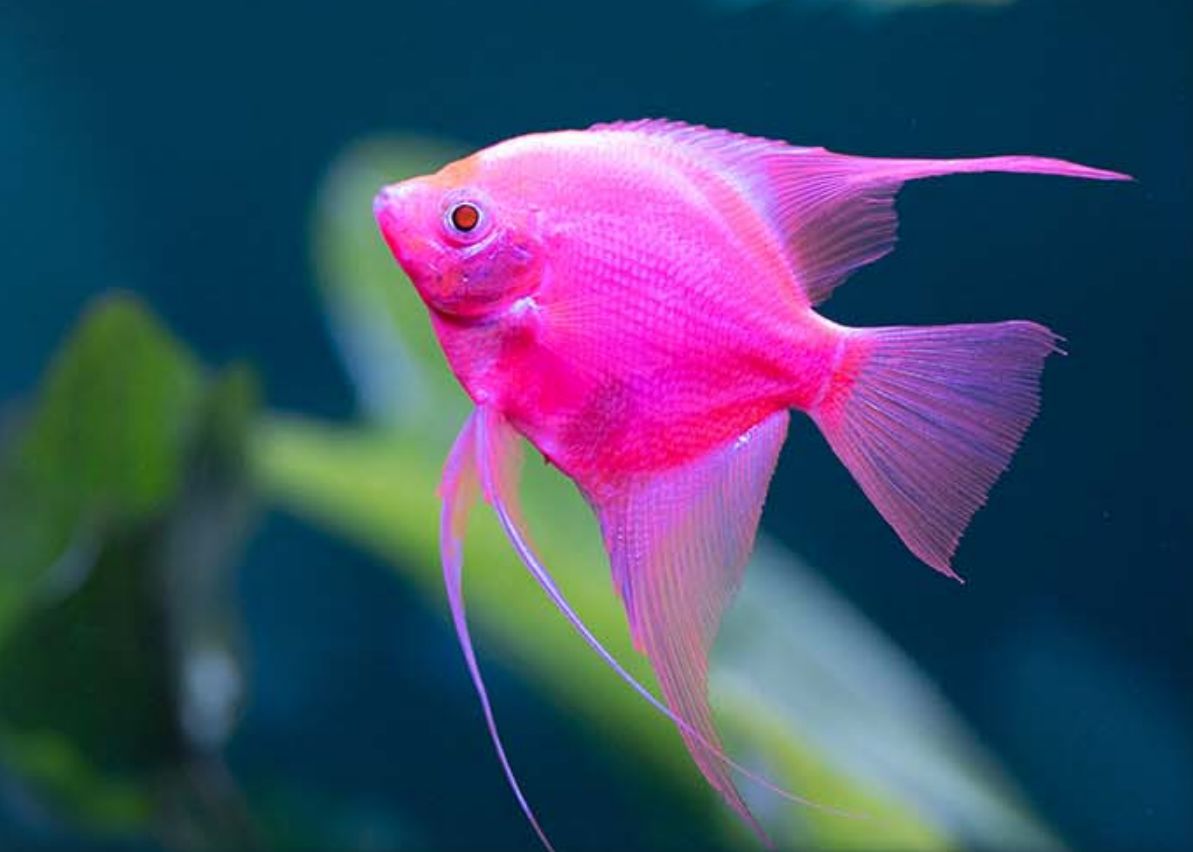
The GloFish Starfire Red Angelfish is a genetically modified variant of the common angelfish, originally derived from the species Pterophyllum scalare. This vibrant fish showcases a striking red hue that radiates under aquarium lights, making it a popular choice among aquarists.
What sets the GloFish® Starfire Red® apart from its wild counterparts is its luminescent color, achieved through genetic engineering that incorporates fluorescent proteins. While standard angelfish exhibit more muted colors and patterns, the GloFish® variant offers an eye-catching alternative that adds a unique flair to any aquarium.